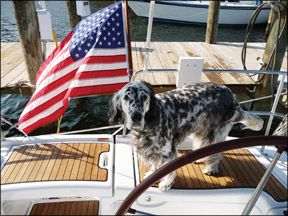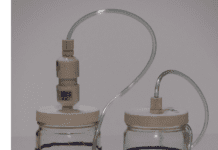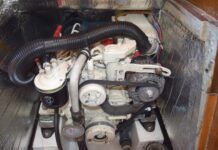Here’s my input on some products you have reviewed: Barnacle Barrier (August 2003): Last year, I used Barnacle Barrier on my 19-inch MaxProp. When I went to reapply this spring, I could not get the paint off, so I sanded it down as much as I could and painted right over the old coat. I put the boat in the Chesapeake in April. Diving the prop on Labor Day, I noticed there were absolutely no barnacles or growth. I hauled the boat in mid-December, and there were about 10 barnacles on the entire prop. The best part is that the paint costs $16. I can do at least two applications with $25 worth of paint; it is simple and quick to apply, and it works great!
TeaQua and Semco (October 2007, December 2009): I have usually used Semco, but last year, I switched to TeaQua. I put two coats on in July and applied another in October. I keep a cover on my boat over the winter, so I didn’t have to reapply until July this year—a respectable performance for the amount of work involved, and I really like the look.
TeaQua blows Semco away in application. The biggest difference is that Semco is oil-based and TeaQua is water based, making TeaQua substantially easier to apply and cleanup.
Neither will last as long as varnish, but they also won’t chip, peel or crack, and the application process is simple. With TeaQua, there is no sanding, no dust clean up, no acetone wipes, no multiple coats, or any worry about a heavy dew spoiling the finish. It is slapped on in minutes and lasts a year.
Peter Carlson,
Beneteau 40
Solomons, Md.

Photo courtesy of Peter CarlsonPhoto by Ralph Narajo
288
While we recommend Semco for teak decks, TeaQua is a comparable finish for trim and other exterior brightwork. It didn’t do as well in our panel test (December 2009) as it did on your boat, unfortunately; but the test conditions—a year of full exposure in the central-Florida sun and rain—are admittedly more harsh than those your teak faced. A year is about as long as you can expect these easy-to-apply treatments to last. We’re currently testing a few new, similar products that we received after our long-term panel test was launched. Stay tuned for the upcoming head-to-head report on the whey-based Vermont Natural Coatings finishes and water-based Captain John’s Teak Preserver.
It has been my experience over many years of boating that fighting corrosion in both obvious and hidden locations is a Sisyphean task. I would like to add one more product to the list of corrosion preventatives you should test, and in my opinion, may be one of the best: Lanocote, which is marketed by Forespar Products. I have used it in like-metal and dissimilar metal connections, and in various electrical contact applications, and I must say that it works long-term.
I am not exactly sure of the chemistry of this product, but I seem to remember being advised that ingredients include beeswax and lanolin, both of which, one would think, are highly saltwater resistant. I must say I’ve never been tempted to try anything else.
R.D. Unice,
Warren, N.J.

Photo courtesy of Peter CarlsonPhoto by Ralph Narajo
288
Choosing a lubricant depends on how and where you plan to use it. Waxes like Lanocote work particularly well in areas that are often wet because they create a good barrier. We actually did test Lanocote for the May 1, 2002 report on anti-corrosion sprays. Tested against 17 other inhibitors, Lanocote performed in the middle of the pack, but testers noted that it was the only wax product that left a tacky residue. It was not recommended for electric components, and it allowed more rust over the longhaul than other test products, so it wasn’t included in the next round of testing in 2007. Our top picks in our most recent report on corrosion inhibiting sprays (April 2007) were CorrosionPro Lube, CRC Heavy-duty Corrosion Inhibitor, and LPS 3. However, we still like Lanocote as a general-purpose stainless-fastener lubricant.
With regard to your recent article on bosun chairs (June 2010): As a systems engineer, my major focus has become safety. I have been an avid supporter of Brion Toss and learned many useful knots from his books. But one of my students, a certified arborist who climbed trees where hydraulic buckets couldn’t go, recently taught me something new: The Blake hitch, a knot regularly used by tree climbers. While most of us will still use a multi-purchase block and tackle or a winch to get us up the mast, a second rope with a Blake hitch is a fantastic “safety line” that is very easy for the person in the bosun chair to manage while going up and down.
Videos on how to tie the Blake hitch can be found online. But basically, a second line is hoisted with a simple block to the top of the mast with the long end flaked on the deck. The shorter end (standing part) is tied to the D-ring of the bosun chair or harness with a long tail, and the tail is then tied to the long, vertical rope.
The Blake hitch is tied by taking four turns stacked vertically up the rope, then down and around the standing line coming from the D-ring, then up through the lower two turns, and out. (See illustration.) The coils are carefully snugged until they are like a “stack of coins.” When there is a slight angulation in the knot, it won’t slide on the vertical rope. But when a hand holds the knot in line with the rope, it slides freely. So as a person is being hoisted up the mast, he simply slides the knot up the rope.
The knot was specifically designed so if the user is knocked out or physically pushed away by a limb, he absolutely won’t fall.
Peter J. Fabri MD, PhD
Tampa, Fla.

Photo courtesy of Peter CarlsonPhoto by Ralph Narajo
288
The illustration above shows how to tie the Blake’s Hitch, but Animated Knots by Grogg (www.animatedknots.com) offers a good video of it. We tested similar gripping and climbing knots in the August 2009; also check out the reader letters with other knot advice in the September 2009 Mailport.
We previously had a brief exchange (and you published my letter in November 2009) about how to remove Cetol. I’m preparing my Morris Annie for sale, and want her to look good, so I decided to bite the bullet with the brightwork. I find that a heat gun and scraper followed by sanding is relatively easy (but time consuming). The Cetol melts quickly and scrapes off well. Just thought I’d share.
George Braun,
Jeanne Marie, Morris Annie No. 9
Greenport, N.Y.
Regarding the letter in the February issue about the plotter fogging problem: I believe I can shed some light on how it happens. I used to build a line of watering machines for commercial greenhouses. They included a membrane keypad in a waterproof box. After being submerged in a 5-gallon bucket of water for a week, they emerged completely dry. Yet after a month in a greenhouse, they contained a teaspoon of water and corrosion was destroying everything!
So how does water get in the keypad? It comes in through the spaces between the round wires in the cord. It also come in through the spaces between the strands of conductors within the individual wires. During the day, the box heats up and pushes air out through the cable. At night, it cools and sucks moisture in, where it condenses. As this cycle repeats, the box fills with water. We found that the corrosion doesn’t happen if condensation can’t happen. Keeping the housing slightly warmer than ambient does the trick.
I’d bet that this is the mechanism at work with the chartplotter. It sits in the sun, cools at night, and has a cable penetrating the housing with a watertight connector. If you left it on all the time, the problem would never occur, but of course, that’s not possible.
Gary H. Lucas,
Via e-mail
In the February 2010 article on LED tri-color nav lights, your mention in passing of built-in voltage regulation circuitry in LED lights seems to accept the need for it without scrutiny or recognition that it vastly increases the price of such lights with very little benefit. Elaborate microelectronic circuits also greatly complicate what should be a simple device with only a few solder connections and two microscopic junctions per lamp. Regulation chips have very complex design with literally thousands of microscopic junctions, any one of which could cause loss of light output. Compare this to the simplicity of an incandescent bulb with no RFI.
We always have had a valuable function with incandescent bulbs in the way they grow dim if our batteries are getting low. LEDs will do the same when connected directly to onboard power. Regulated cabin lighting will drain the batteries to the point of failure with no clue about voltage levels.
I easily replaced all the lighting on my boat with LEDs at prices of $4 to $20 each from www.superbrightleds.com. I have had no failures due to voltage spikes while the engine is running. I have noticed no variation in brightness. The prices are reasonable enough to carry a few spares. After a year, two light panels with 24 LEDs had a few dead elements, which I received free replacements for.
If I wanted to regulate the power going to my masthead, steaming, and spreader lights, I would put the regulator circuit after the fuse protecting the main power feed to the mast, much preferable to paying extra for microcircuits in the base of each lamp.
Jim Gordon,
Koan 3
Anacortes, Wash.

Photo courtesy of Peter CarlsonPhoto by Ralph Narajo
288
Aside from being energy misers, one of the pluses of LEDs over incandescent lightbulbs is their comparatively long lifespan, and not regulating their voltage, or connecting them directly to onboard power, will burn them out more quickly.
According to engineers at Lopolight Marine Lighting, all LEDs require a certain amount of current to be sent through the semiconductor substrate in order to emit light, typically between 1.5 and 3 volts. If the supply voltage exceeds the LEDs’ specific voltage, the semiconductor will be damaged. When the bulbs are being powered by lead-acid batteries as they are in an onboard setup, that supply voltage can easily vary from 11 volts with a flat battery to 14 volts when the battery is charging. A regulatory circuit constantly monitors and regulates the incoming voltage to keep the bulb from being damaged. This ability to accept a varying supply voltage is required to meet national and international standards for LED nav lights.
Having the regulating circuitry housed in the LED itself also means there are fewer failure points than in setups that place the regulator outside the housing (i.e. “after the fuse at the power feed to the mast”), and it also ensures that each bulb is constantly getting the specific voltage it needs to avoid damaging the semiconductor. Having one regulating circuit handle multiple bulbs could result in one getting more voltage than can be tolerated by its semiconductor.
We appreciate money-saving DIY setups as much as anybody—and an unregulated LED may be fine for cabin lighting—but for navigation lights, we’d rather pay a little more and know that the bulb meets safety standards and that the voltage is being regulated properly, thereby extending the life of the bulb and delaying any need to go aloft to replace it.
In your July 2010 issue, you ask for input regarding antifouling for props. I have a three-bladed Max prop on a J/42 and have had great success using Pettit’s Barnacle Barrier. It not only prevents barnacles for two years, it greatly extends the life of the conical-shaped zinc on the prop. I spray on several coats right out of the can onto the prop, strut, and shaft (not the zinc), and that’s all there is to it.
Bill Boyeson,
Jiminy, J/42
Seattle, Wash.



































